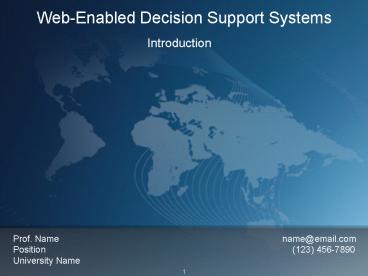WebEnabled Decision Support Systems - PowerPoint PPT Presentation
Title:
WebEnabled Decision Support Systems
Description:
A decision support system (DSS) gives its users access to a ... Active Server Pages .NET (ASP .NET) Hypertext markup language (HTML) Crystal Report .NET ... – PowerPoint PPT presentation
Number of Views:34
Avg rating:3.0/5.0
Title: WebEnabled Decision Support Systems
1
Web-Enabled Decision Support Systems
- Introduction
Prof. Name
name_at_email.com Position
(123) 456-7890 University Name
2
Overview
- 1.1 Introduction
- 1.2 Defining a Decision Support System
- 1.3 Web-Enabled Decision Support Systems
- 1.4 Decision Support Systems Applications
- 1.5 Textbook Overview
- 1.6 Summary
3
Introduction
- A decision support system (DSS) gives its users
access to a variety of data sources, modeling
techniques, and stored domain knowledge via an
easy to use graphical user interface (GUI). - Imparting DSS development skills, which combine
OR/business skills with information technology
(IT) skills, will make students highly sought
after in the modern workplace. - We will build Windows-based, single-user database
applications using - Visual Basic .NET (VB .NET)
- Microsoft Access databases
- Active Server Pages .NET (ASP .NET)
- Hypertext markup language (HTML)
- Crystal Report .NET
4
Overview
- 1.1 Introduction
- 1.2 Defining a Decision Support System
- 1.3 Web-Enabled Decision Support Systems
- 1.4 Decision Support Systems Applications
- 1.5 Textbook Overview
- 1.6 Summary
5
Defining a Decision Support System
- A decision support system (DSS) is a model-based
or knowledge-based system intended to support
managerial decision making in semi-structured or
unstructured situations - Brings together human judgment and computerized
information - Uses data
- Provides a clear user interface (GUI)
- Incorporates the decision makers own insights
- Not meant to replace a decision maker
- Rather, it extends his/her decision making
capabilities - Improves the effectiveness of decision making
rather than its efficiency
6
DSS Components
- A DSS is an intelligent information system, an
extension of the common management information
systems (MIS) - A more sophisticated MIS that allows the use of
models and knowledge bases to process the data
and perform analysis
Schematic View of a Decision Support System
7
DSS Components (cont.)
- Database
- Provides the data with which decisions are made
- Model Base
- Contains statistical, financial, optimization, or
simulation models that provide the analysis
capabilities - Knowledge Base
- Allows special expertise to be stored and
accessed - GUI
- Covers all aspects of communication between a
user and a DSS application - Perhaps one of the most important components of a
DSS - User
- The person who uses the DSS to support the
decision making process
8
Overview
- 1.1 Introduction
- 1.2 Defining a Decision Support System
- 1.3 Web-Enabled Decision Support Systems
- 1.4 Decision Support Systems Applications
- 1.5 Textbook Overview
- 1.6 Summary
9
Web-Enable Decision Support Systems
- Today, the era of the internet has taken
information sharing to new heights - Billions of users to share information on the
World Wide Web (WWW) simultaneously - A web-enabled decision support system is a DSS
that can be accessed on the world-wide web via
the internet - System requirements
- Data
- Database management system (Access)
- Programming language (VB .NET)
- Mechanism for web-enabling (ASP .NET)
10
Overview
- 1.1 Introduction
- 1.2 Defining a Decision Support System
- 1.3 Web-Enabled Decision Support Systems
- 1.4 Decision Support Systems Applications
- 1.5 Textbook Overview
- 1.6 Summary
11
Decision Support System Applications
- Online shopping
- Car production
- Railroad car management
- Stock portfolio management and optimization
- Television advertisement allocation
12
Overview
- 1.1 Introduction
- 1.2 Defining a Decision Support System
- 1.3 Web-Enabled Decision Support Systems
- 1.4 Decision Support Systems Applications
- 1.5 Textbook Overview
- 1.6 Summary
13
Textbook Overview
- Developing Web-Enabled Decision Support Systems
describes how to - Design a database
- Implement databases using the Microsoft Access
DBMS - Add additional application functionalities using
the VB .NET programming language - Demonstrates web-enabling using ASP .NET
scripting language - Introduces six case studies based on practical
situations taken from the domains of science,
engineering, and management
14
Modules
- The book contains the following five modules
- Principles of Good Database Design
- Object-based modeling and record-based modeling
- Database Development with Microsoft Access
- Introduction to a relational database management
system - Windows Application Development with VB .NET
- Walk through of a complete database application
- Web Application Development with ASP .NET
- Extension of stand-alone Windows applications
- Case Studies
- Illustrates the relevance and importance DSS in
the fields of industrial and systems engineering,
business, and general engineering
15
Overview
- 1.1 Introduction
- 1.2 Defining a Decision Support System
- 1.3 Web-Enabled Decision Support Systems
- 1.4 Decision Support Systems Applications
- 1.5 Textbook Overview
- 1.6 Summary
16
Summary
- Decision support systems (DSS) are model-based or
knowledge-based systems that support managerial
decision-making. - They are not meant to replace decision makers,
but to extend their decision-making capabilities. - There are five components to a DSS
- Database
- Model base
- Knowledge base
- GUI
- User
- A web-enabled decision support system is a DSS
that can be accessed on the World Wide Web via
the internet.
17
Summary (cont.)
- Part I of the book covers the principles of good
database design. - Part II of the book is dedicated to Microsoft
Access, a relational database management system
(DBMS). - Part III of the book presents VB .NET as a
database programming language. - In Part IV of this book, we illustrate the web
application development process with ASP .NET. - Part V of the book features six case studies.
18
Additional Links
- Add links here.































